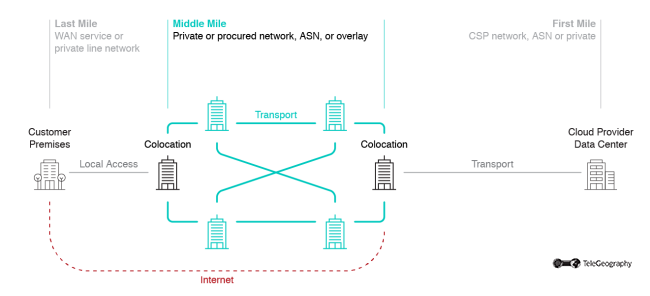“Middle mile” loosely refers to the network segment between local access and destination network.
From the perspective of a potential customer, it might refer to whatever happens between its connection with the service provider and its application in the cloud.
Our Internet Middle Mile research service dives into the expanding world of vendors catering to this sector, optimizing connectivity between employees and their cloud services.
Today I want to lay some groundwork for our readers on the changing network landscape. (And in the future, we plan to explore different types of vendors and their different methods of optimizing connectivity.)
How Did We Get Here?
With enterprises increasingly reliant on applications hosted remotely, the stakes for network services have never been higher. A new category of network service provider has emerged to optimize connectivity between employees and their cloud services. (Actually, there are several categories, and not all the providers are new.)
But all these providers are seeking a role in the enterprise WAN market that no longer relies solely on MPLS IP VPN. It also doesn’t rely entirely on internet access—not without augmentation from other services.
But all these providers are seeking a role in the enterprise WAN market that no longer relies solely on MPLS IP VPN. It also doesn’t rely entirely on internet access—not without augmentation from other services. Identifying and remediating or circumventing internet transmission problems is a primary role these operators play.
Internet connectivity is highly available and spans the entire link between user and application, yet it’s vulnerable to poor performance. More direct, private connections afford more assurance but involve more management burden and cost. The goal is to optimize connectivity performance without introducing onerous cost and complexity. This analysis examines new propositions for optimizing that task.
What is the “Middle Mile?”
One way to characterize network service providers is with their focus on the “middle mile” of the network.
The term initially referred to the network segment between the core network backbone and local access. It emerged in U.S. broadband stimulus and universal service discussions in 2009, particularly in linking underserved broadband access providers to internet backbone networks.
This usage was in the spirit of traditional telco networks with core, metro, and access tiers.
More recently, enterprise network service providers have adopted the “middle mile” term. It still refers to the network segment between the access and destination network. But rather than access to the internet backbone and content linked to it at large, the destination is apt to be a more discrete service host, usually a cloud service provider (CSP) network.
Access remains consistent but focused on enterprise locations.
From the perspective of a potential customer, the middle mile might refer to network traffic links between its connection with the service provider and its application in the cloud or other destination network, like a supply chain partner. The focus for that customer is application performance. Network connectivity contributes to remote-hosted application performance.
Network professionals use the term “last mile” to describe the local access network segment. “Middle mile” is a logical companion. We can extend that nomenclature end to end. Supply chain logistics professionals describe initial delivery of goods from the factory as “first mile.” Let’s use that term to describe the cloud-based application host network.
Middle Mile Network Overview

There are many ways to traverse the link between user and application over the WAN. Here’s a schematic of the basic network segments, left to right:
- Last Mile: Local access connects an enterprise location to the nearest colocation facility. Traffic may cascade through local aggregation points
- Middle Mile: Switching and transport shepherds traffic between the local access colocation and the cloud service provider network. That’s what this report is about
- First Mile: This is the cloud provider or other destination network. Traffic is now on-net with the application host
- Internet traverses these Layer 1 & 2 segments at Layer 3
Depending on where traffic exchanges with the CSP network, the middle mile can be long or short in proportion to the first mile.
CSPs generally have more edge PoPs than on-ramps. On-ramps host the most direct connections: cross-connects from other networks onto the CSP private network. Edge PoPs onboard internet traffic by peering with other internet operators.
The nature of the cloud network also depends on the type of CSP. Major infrastructure as a service providers like Amazon Web Services and Microsoft Azure have extensive transport infrastructure of their own. Software as a service providers like Salesforce are more apt to interconnect with peering and IP transit.
You can explore all of TeleGeography’s WAN content over here.
And for more data on this topic, peruse our related research service.
Greg Bryan
Greg is Senior Manager, Enterprise Research at TeleGeography. He's spent the last decade and a half at TeleGeography developing many of our pricing products and reports about enterprise networks. He is a frequent speaker at conferences about corporate wide area networks and enterprise telecom services. He also hosts our podcast, TeleGeography Explains the Internet.


